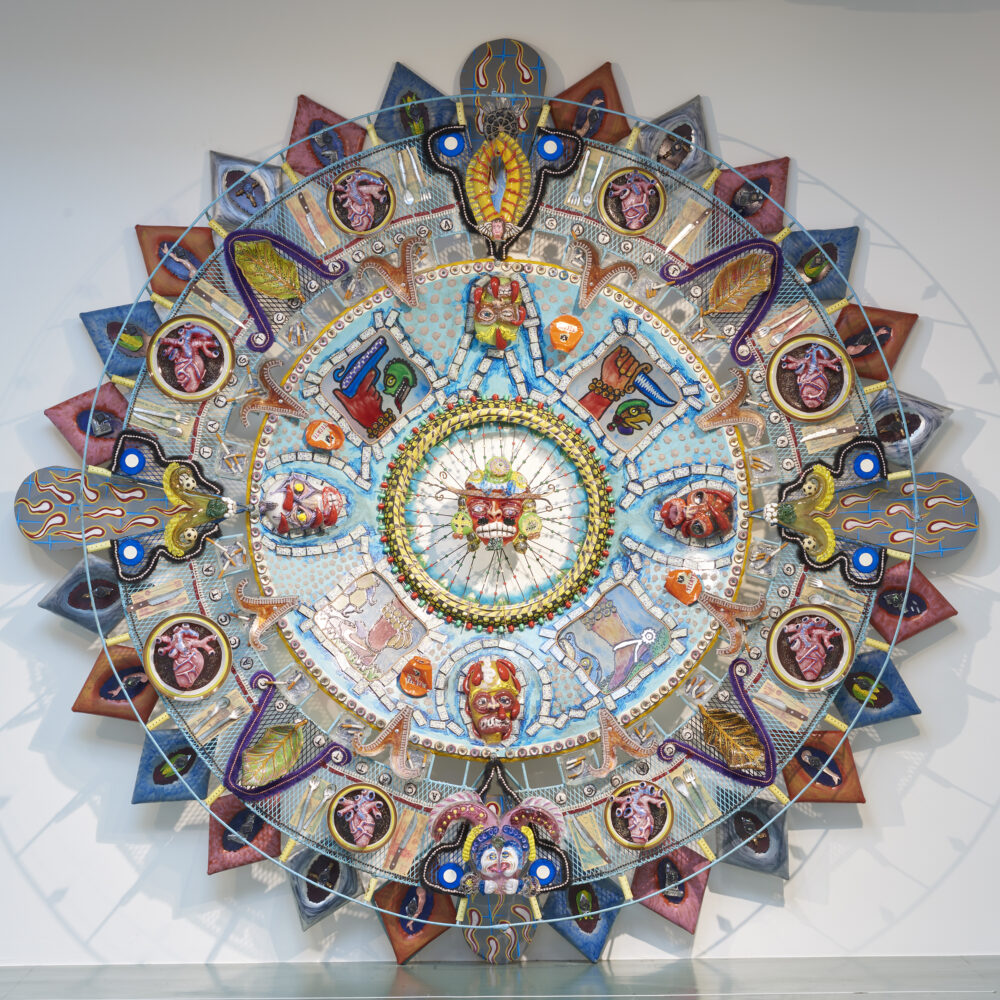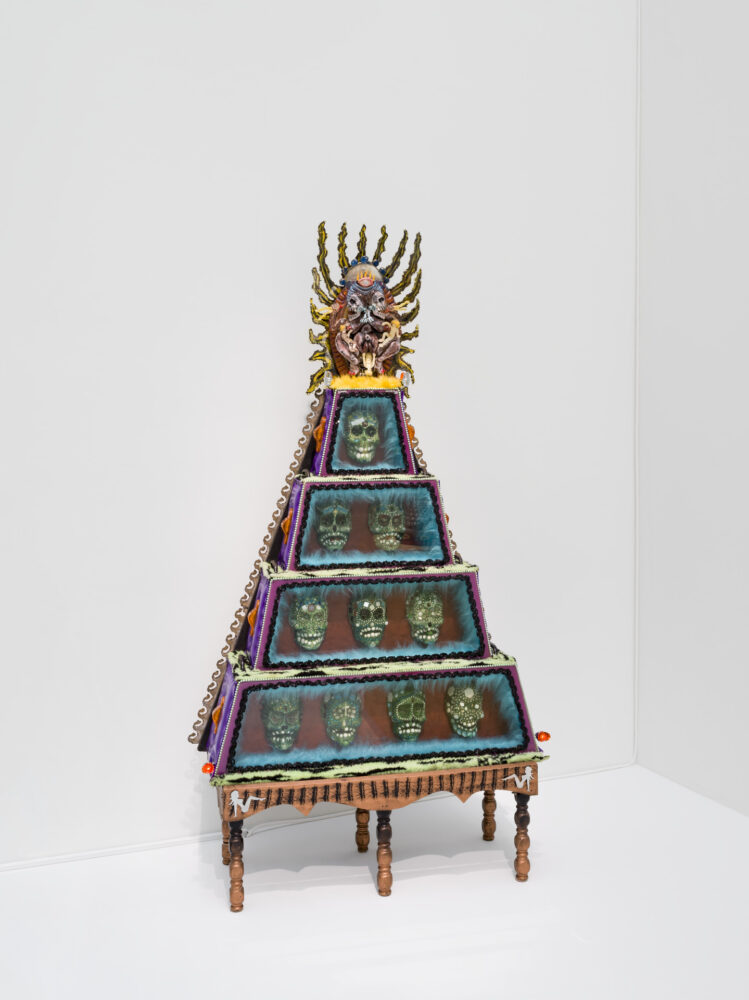
Figure 1: Einar (Mexican, 1963–) and Jamex (Mexican, 1960–) de la Torre. “Oxymodern (Aztec Calendar),” 2002, blown-glass, mixed-media wall installation, 120 x 120 x 12 in. Courtesy of the Cheech Marin Collection and Riverside Art Museum.
By Annie Carlano
Einar and Jamex de la Torre (born 1960 and 1963, respectively) have energized and expanded the notion
of contemporary glass. The dynamic duo uses the performative nature of blown glass to express their views on binational identity, politics, religion, and pop culture. For “the brothers,” as they are known, art making is an additive process and goes beyond glass. Their creations combine found appropriated objects with resin, laser-cut metal, and lenticular prints. Colorful and exuberant, neo-Baroque, and over the top, the playfulness often masks an acerbic commentary on colonialism and corruption.
“The title of the exhibition mirrors the artists’ use of wordplay, alluding to the kaleidoscope-like quality of their works and the collision of imagery, themes, and references that comprise their artistic language,” says exhibition curator Selene Preciado. “The artists use critique layered with humor as a tool to unpack the tensions and contradictions of our postcolonial transcultural identity.”
Born in Guadalajara, Mexico, Einar and Jamex moved to California with their Danish-Mexican mother in 1972. The culture shock wore off as they enjoyed the relative freedom and entrepreneurial spirit of their new home.
Experiments with lampworking led to a small business venture, and further study at California State University exposed them to a variety of art media and the collaborative nature of blown glass. Working together since the 1990s, they dismissed the minimalist trends of the art world to pursue a maximalist aesthetic, drawing on multicultural sources, religious imagery, “Flemish Surrealism” — the paintings of Bosch and Breughel — German Expressionism, and current events. In the last 15 years, the brothers have added photo-mural installations and lenticular prints to their repertoire, heightening viewers’ senses and asking each viewer to take a closer look.
A Retro-Perspective is their take on a traditional retrospective, which this is not. This exhibition eschews chronology and is more like a party than a survey.
Spanning a 30-year period, Collidoscope is organized into five sections: “Histerical Vignettes,” “Hybrid Dislocations,” “Systems and Cycles,” “Retracollage,” and “Other Works.”
Hybrid Dislocations
Oxymodern (Aztec Calendar), in the section “Hybrid Dislocation,” is a mixed-media timepiece based on the design of the Mesoamerican Aztec sun or calendar stone and Asian mandalas, (figure 1). Depicted are eight dinner settings with human hearts sitting on a bed of mole sauce accompanied by Mexican bank note napkins. Four faces or characters are engaged in a game of dominos surrounded by snuffed-out cigarettes and squished beer cans. The brothers are making fun of the ways in which modern man passes the time.
Also, from “Hybrid Dislocation” is Baja Kali, (figure 3). This pyramid structure is named for Baja California, Mexico, where the brothers live part time, and the Buddhist goddess Kali. The goddess Kali is conceptually and visually blended with the Aztec goddess Coatlique, both representing Mother Earth and the life cycle, in the depiction at the top of the pyramid, where the blown glass and lampworked figures are born and devoured. An outstanding example of the brothers layered cultural narratives, Baja Kali was well received in bohemian California circles and rented to the Lollapolooza festival as a set design for their 1995 tour.

Figure 3: Einar (Mexican, 1963–) and Jamex (Mexican, 1960–) de la Torre, “Baja Kali,” 1995, blown-glass, lamp-worked glass and mixed-media sculpture, 87 x 45 x 17 in. Courtesy of Einar and Jamex de la Torre and Koplin Del Rio
Histerical Vignettes
“Histerical Vignettes” includes !2020! (figure 4), a work featuring a tattooed baby emperor who heralds in the new year. Conceived during COVID, the baby holds a remote, and the brothers ponder, who really has control of 2020. After searching for the perfect baby doll, the brothers found this one and made a blown-glass head and headdress. The head is a nod to the sugar skulls given out during Dia de Muertos (Day of the Dead) and to the candy-like appearance of blown glass in general. Found trinkets decorate the bed frame and posts, and the clear dishes under the legs of the bed conceal bedbugs.

¡2020! (detail), 2020, mixed-media, blown-glass sculpture with resin casting, 33 x 22 x 14 in. Courtesy of Koplin Del Rio Gallery.
Systems and Cycles
A lenticular print revealing two distinct scenes as one moves sideways, Feminencia, another made up word combining the Spanish for feminine and the Spanish for eminence, is a feminist work. A part of the “Systems and Cycles” section, it celebrates the strength and power of the female sex, both carnal and spiritual. Made after the brothers returned from an extensive European trip in 2020, one scene depicts a nervous King Leopold of Belgium (1790-1865) surrounded by female nudes depicted in French and Flemish paintings, including, at his feet, Gabrielle d’Estrées and one of her Sisters, 1575-1600, Musee du Louvre. Moving to the other side of the work, a second image appears: the sculpture of the Buddhist goddess White Tara, a gift of the Nepalese government to Mexico. Through the digital magic of photoshop the brothers layered images of Austrian churches and the Eiffel Tower to heighten the sensation of divine wisdom.
Annie Carlano is the exhibition curator and senior curator of Craft, Design, and Fashion at The Mint Museum.